With school closures higher than the average in Latin-America, and only inconsistent access to remote learning on offer, Brazilian basic education is going through a crucial period that could deepen historical problems around truancy, learning gaps, and educational inequality. Recently published surveys in the field of education economics attempt to measure the impact of the pandemic, especially on students enrolled in the public-school system. World Bank analyses targeting the consequences of Covid-19 in the education sector indicate that two out of three students in Latin America and the Caribbean may reach the age of ten without the ability to read simple texts, while the United Nations Children’s Fund (UNICEF) has estimated that about four million Brazilian children dropped out of school during the past year. To remedy this situation, the researchers are calling attention to the need for investments in technological resources and support for educational institutions, and for the establishment of safety protocols when students go back to in-person classes.
Cover
Education at risk
Prolonged school closings and unequal access to distance learning is causing increased student dropouts and learning-acquisition gaps
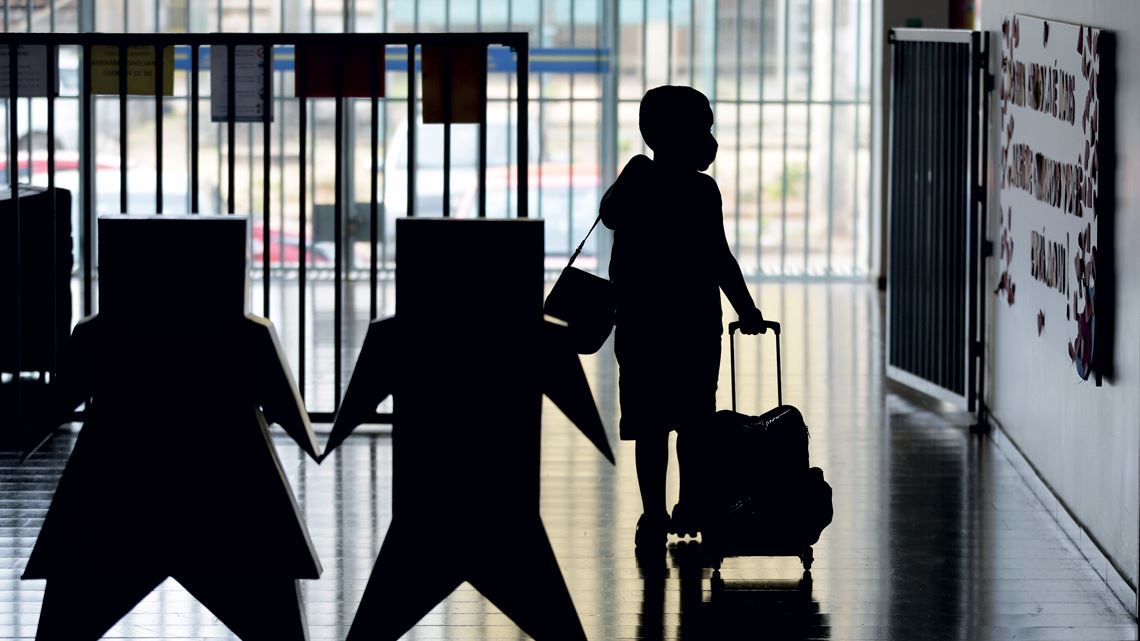
Eraldo Peres / AP Photo / Imageplus

Last year in Latin America and the Caribbean about 170 million students were affected by school closures, for an average period of 160 days. If the impacts of the Covid-19 pandemic on education through the beginning of 2021 are taken into account, the region may record the second largest rise in learning poverty in the world, as much as 20 percent according to a World Bank study released in March. “We use the idea of the ‘monetary poverty line,’ which establishes the minimum daily amount for a person to survive, in order to create similar measures of learning poverty,” explains one of the study’s authors, Rio Grande do Sul economist Ildo Lautharte. He adds that children who reach ten years of age without being able to read a paragraph at their age level are considered learning poor and may suffer the consequences of this condition throughout their education, to the extent that “mastery of the Portuguese language works like a scaffolding from which all other disciplines develop.”
Thinking along similar lines, economist André Portela, from the São Paulo School of Economics of the Getulio Vargas Foundation (FGV-EESP), observes that 6-year-old children in the emergent literacy phase tend to be one of the most disadvantaged groups. “At 7 or 8 years of age children consolidate their early-learning literacy, which started at age 6, so any losses accumulate,” he says. Lautharte recalls that the current percentage of children in the region who are unable to read and understand a simple text by the end of fifth grade is already high, at 51%. With the public schools closed for a period equivalent to 70% of the academic year, this number may rise to 62.5%, which represents another 7.6 million young people with learning deficits. The economist explains that even before the pandemic there were about 70 million children on the learning poverty line.
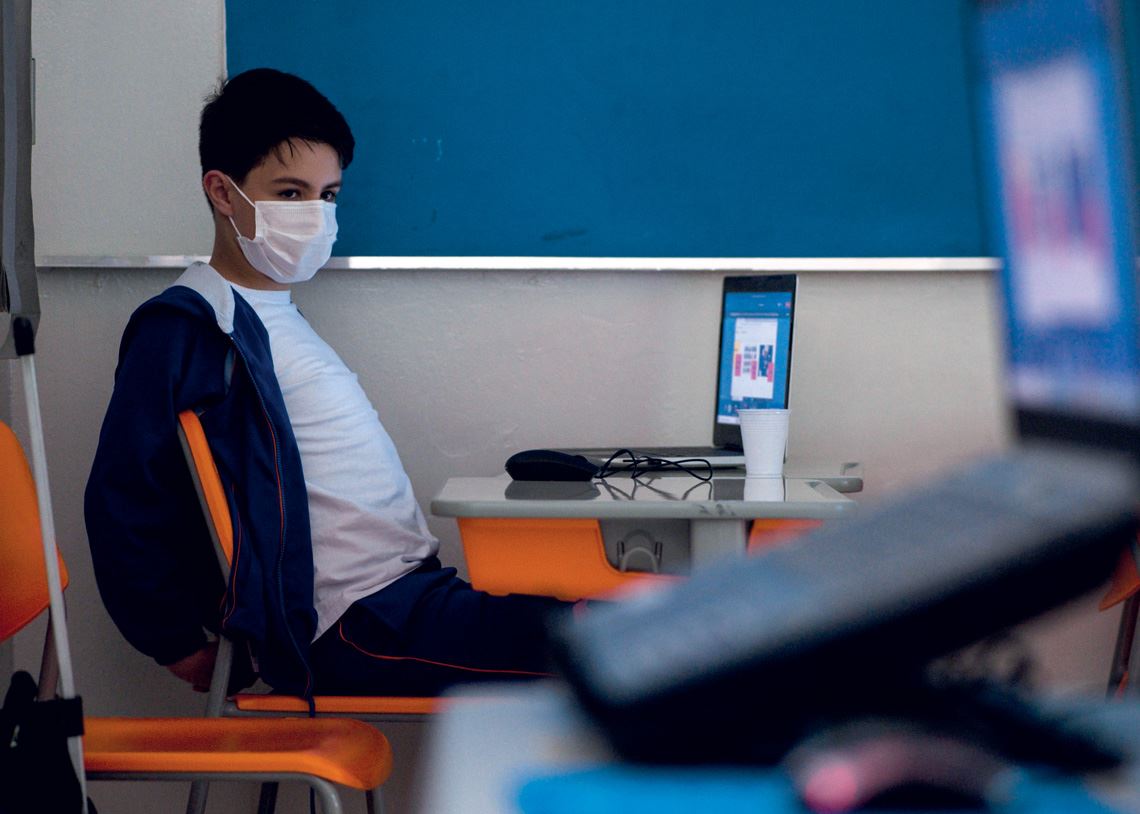
Léo Ramos Chaves
A young person during class at a school in São Paulo: education systems need to be prepared to receive studentsLéo Ramos ChavesWorld Bank analyses also indicate that Latin America and the Caribbean may see the greatest absolute growth in the percentage of students below the minimum proficiency levels as measured by the International Student Assessment Program (PISA), a comparative study conducted every three years by the Organization for Economic Cooperation and Development (OECD). Taking into consideration ten months of school closures and the modest effectiveness of distance learning strategies—when they could be applied—the number of students below the minimum levels of proficiency established by PISA could rise from the current 55% up to 71%. Poor students tend to be the most affected. This means that by the age of 15, students in the upper quintile of the income distribution may show, on average, a difference of almost three school years in learning as compared to the poorest students. “In Brazil, the effectiveness of distance learning has varied according to the individual student, the region, the state, or the city,” observes Lautharte. In his view, unequal access to remote education will also result in an increase in learning differences between students at the same grade level. “Many Brazilian students don’t have the appropriate learning level for the year they’re enrolled in. For example, some students finish ninth grade with the knowledge level required for the seventh grade,” he adds. This means that with the additional challenges brought on by the pandemic, teachers need to be even more prepared to deal with learning gaps within their classes.
The World Bank survey used data from Brazil’s PISA scores and from the schools participating in the National Basic Education Assessment System (SAEB). Prepared by the National Institute of Educational Studies and Research (INEP) at the Ministry of Education (MEC), the SAEB survey applies large-scale assessments in public schools across the country—participation from private institutions is voluntary. The study also took into consideration children and youth not attending school, through the use of data from the Brazilian Institute of Geography and Statistics (IBGE). “They too, are individuals that are unable to attain minimum levels of proficiency, so our estimates also reflect the impacts of dropouts on the learning landscape,” adds Lautharte. With the prospect that school dropouts could increase by 15 percent this year, the economist notes that the transitions from elementary school to middle school, and from middle school to high school are moments at which dropout rates tend to jump, and up to 25% of students may leave school at these times. “Simple tools, such as questionnaires that measure a family’s socioeconomic level or the difficulties students confront in order to attend school, can help identify which students are more likely to drop out of school,” he observes.

Before the pandemic, 1.3 million school-age Brazilian children and adolescents were not enrolled in educational institutions. A UNICEF survey based on data from the National Household Sample Survey (PNAD) estimates that more than 4 million boys and girls have stopped attending school due to Covid-19. Italo Dutra, head of education at UNICEF in Brazil, says that the increased dropout rates are higher among black, brown, and indigenous communities, especially populations in the North and Northeast of the country, as well as in groups with low socioeconomic status. “We need to develop active search mechanisms for students who’ve dropped out,” he warns, and mentions a platform UNICEF created to support managers with this endeavor.
Educational systems need to be prepared to receive students for in-person classes as soon as the pandemic is under control, Dutra contends, maintaining that the number of Covid cases and deaths must be reduced in Brazil before reopening schools. Released in September 2020, an OECD report shows that countries with the worst levels of academic progress are, on average, those that kept schools closed for the most days. In fact, a survey by the consulting group Voices of Education—developed with support from the Lemann Foundation and the Imaginable Futures fund—shows that while nations such as Germany, the United Kingdom, Denmark, Singapore, and France suspended in-class activities for about 90 days, in Brazil, from March 2020 to January 2021, 267 days were suspended.
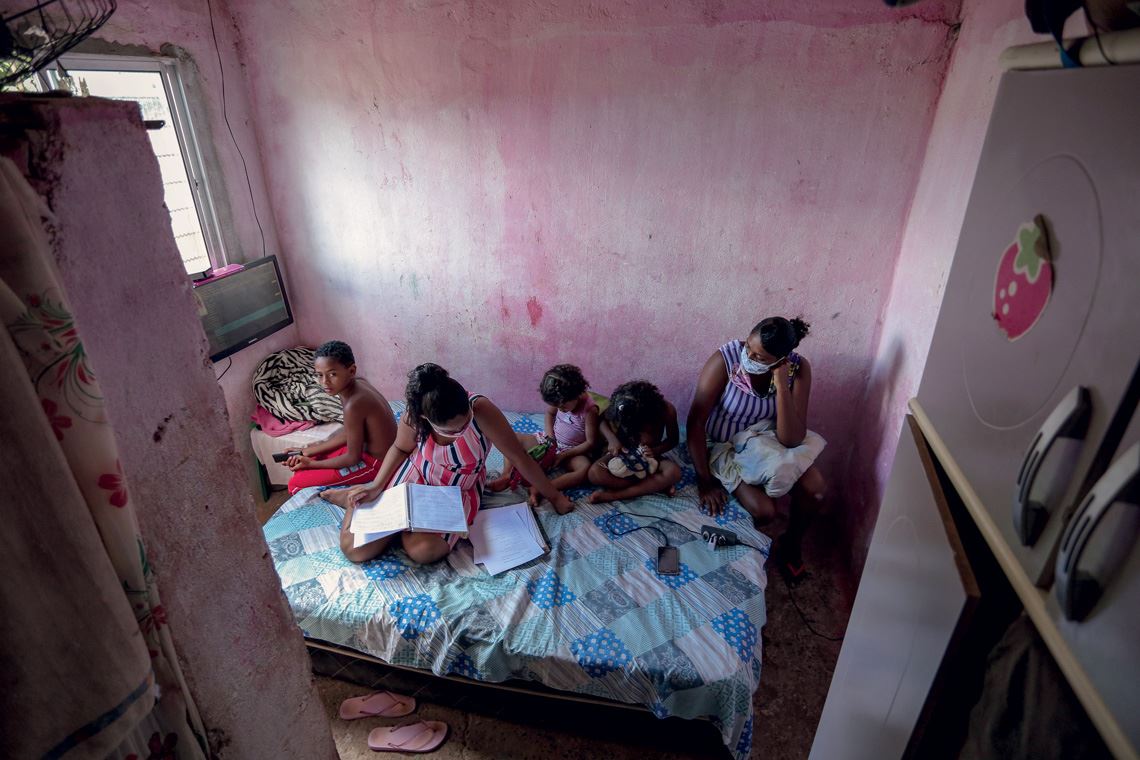
Leo Malafaia / AFP / Getty Images
A student does her homework with her mother and cousins in the city of Camaragibe, in Pernambuco StateLeo Malafaia / AFP / Getty ImagesTo simulate the extent to which closing schools affects learning, the Lemann Foundation commissioned a study from the Centers for Learning on Evaluation and Results for Brazil and Lusophone Africa (CLEAR), linked to FGV-EESP. Released in April, their research analyses were based on the SAEB learning scale, says study coordinator André Portela. For each school year, a student’s learning in Portuguese and mathematics during the final years of middle school is equivalent to a gain of 11 to 12 points on the scale. The study also considered the results of surveys that measured the impacts of closure in other contexts. One of them analyzed the status of students during the H1N1 outbreak in the state of São Paulo, in 2009, when 13 municipalities decided to postpone the return to in-person classes by two or three weeks after the July vacation period. “Based on data from Prova Brasil—the large-scale assessment of Brazilian students which was renamed SAEB in 2019—the survey concluded that institutions that had to postpone in-person classes to mitigate the health risk brought on by the H1N1 outbreak performed five to ten percent worse when compared to other schools,” Portela explains.
According to the FGV-EESP economist, in order to account for Brazilian students’ inconsistent access to remote learning, the survey also included the responses to the Covid-19 PNAD conducted by IBGE. It was possible to identify whether schools were offering remote activities and if children and young people were attending classes from home. From there, FGV created a learning-loss mitigation indicator that could be used to simulate various scenarios. In the worst scenario, in which access to remote education is precarious or non-existent, the pandemic could cause the knowledge level of middle school students to regress four years in Portuguese language studies and three years in math, according to the SAEB learning scale. “Distance-learning activities, even with their limitations, are fundamental in alleviating this situation,” Portela argues.
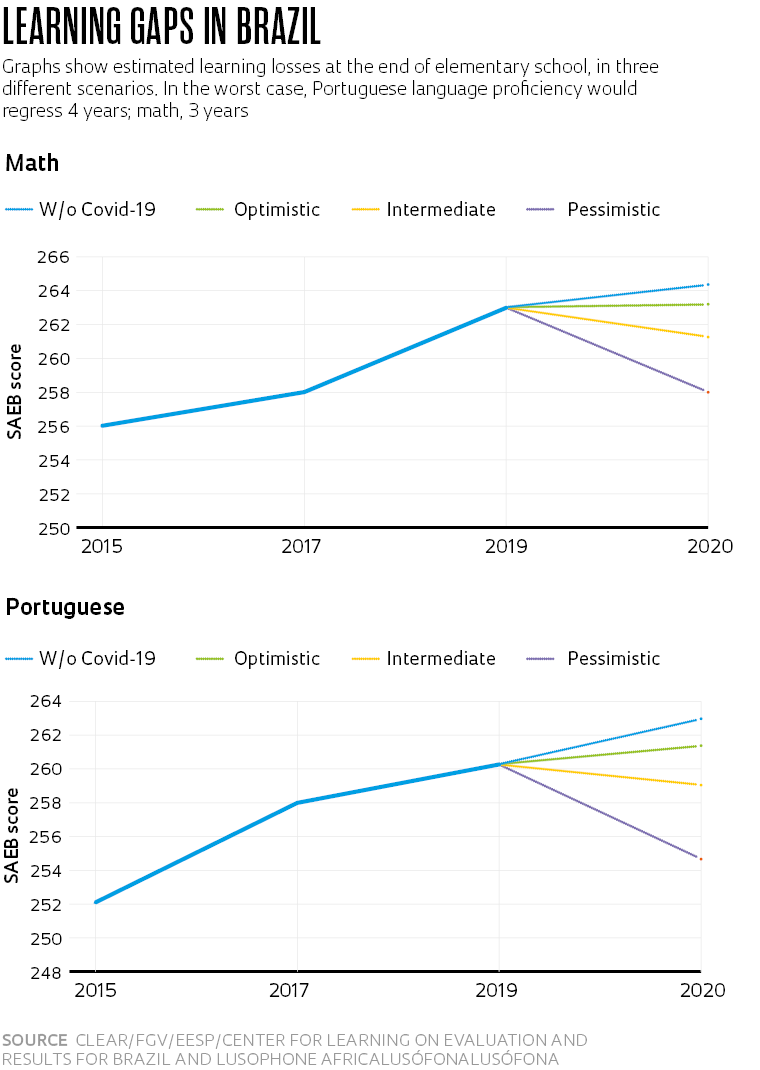
The World Bank research also analyzed how learning-gap problems tend to cause economic losses. With ten months of school closures and the consequent negative impacts on knowledge levels, the study estimates that the Latin American and Caribbean region could lose around US$1.7 trillion, in 2017 values. Lautharte clarifies that this projection was calculated using simulations made with statistical models that predict how much each year of schooling impacts individual productivity. “We found that a person who completes high school increases their annual income by US$2,000 compared to if they had stopped studying during elementary school and went straight to the job market,” the economist says.
Considering such findings, Portela believes one group that deserves special attention are young people who are making the transition from school to the job market. “The literature shows that when this transition occurs during a booming economy, these people have more successful professional outcomes, with better incomes and jobs throughout their lives, while if they transition during periods of crisis and recession the difficulties they encounter entering the labor market over the long term are much greater,” he adds.
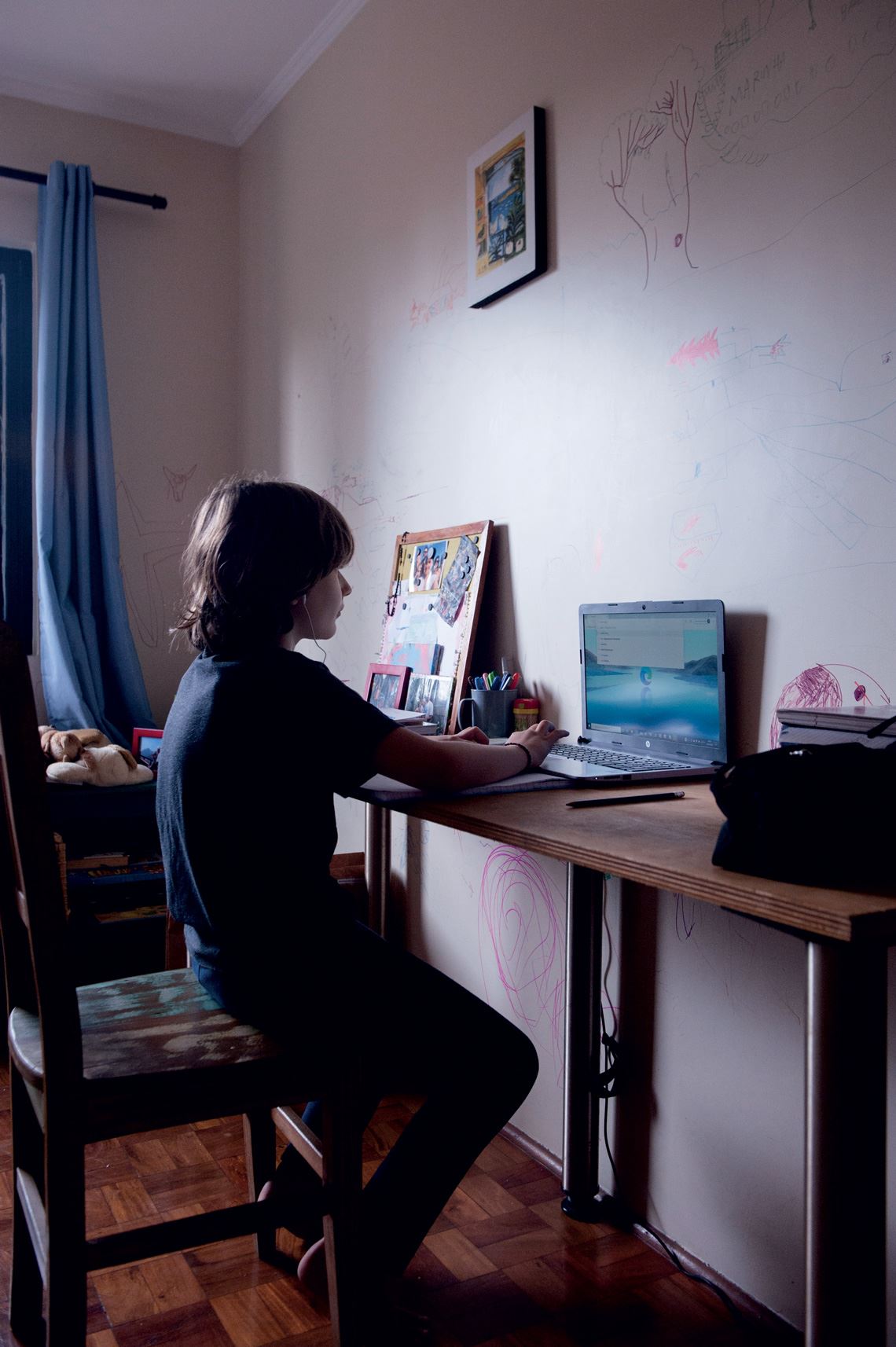
Léo Ramos Chaves
A child at home participate in online classes in São PauloLéo Ramos ChavesIn Brazil, learning difficulties pre-date the pandemic. Mozart Neves Ramos, who holds the Sérgio Henrique Ferreira chair at the Institute of Advanced Studies at the University of São Paulo (IEA-USP) in Ribeirão Preto and is a member of the FAPESP Board of Trustees, observes that since 2003 the Basic Education Development Index (IDEB) had been on the rise in many municipalities, especially for students in the early years of elementary school. The IDEB is calculated using results from the SAEB, which uses academic performance data provided by the School Census. However, in the most recent edition, which was released in late 2020 based on data from the previous year, results had stagnated. “Cities with a high IDEB, around 6 or 6.5 (the index goes from 0 to 10), recorded declining or static scores. Only those with very low performance showed improvement,” he notes. In addition, the latest edition of the index shows that although the average performance of high school students has improved in all states, 95% of public-school students complete their basic education without adequate math skills, and the equivalent measure for Portuguese language learning is at 69%.
Considering that this year the ability to offer educational content happens primarily through distance learning, Ramos decries the lack of a national plan to increase the connectivity of schools, teachers, and students. Conversely, he cites the experiences of public-school systems in São Paulo and Paraná, which offered synchronous classes via media centers and educational applications through partnerships with telecommunications providers. In the case of São Paulo, classes have also been broadcast on TV Cultura [a nationwide TV network similar to PBS]. “Even so, nearly 1 million children and young people in the richest state in the nation still had no access to distance-learning activities. The problem mainly affected populations living in pockets of poverty, without access to connectivity or electronic devices such as computers and cell phones,” he adds.
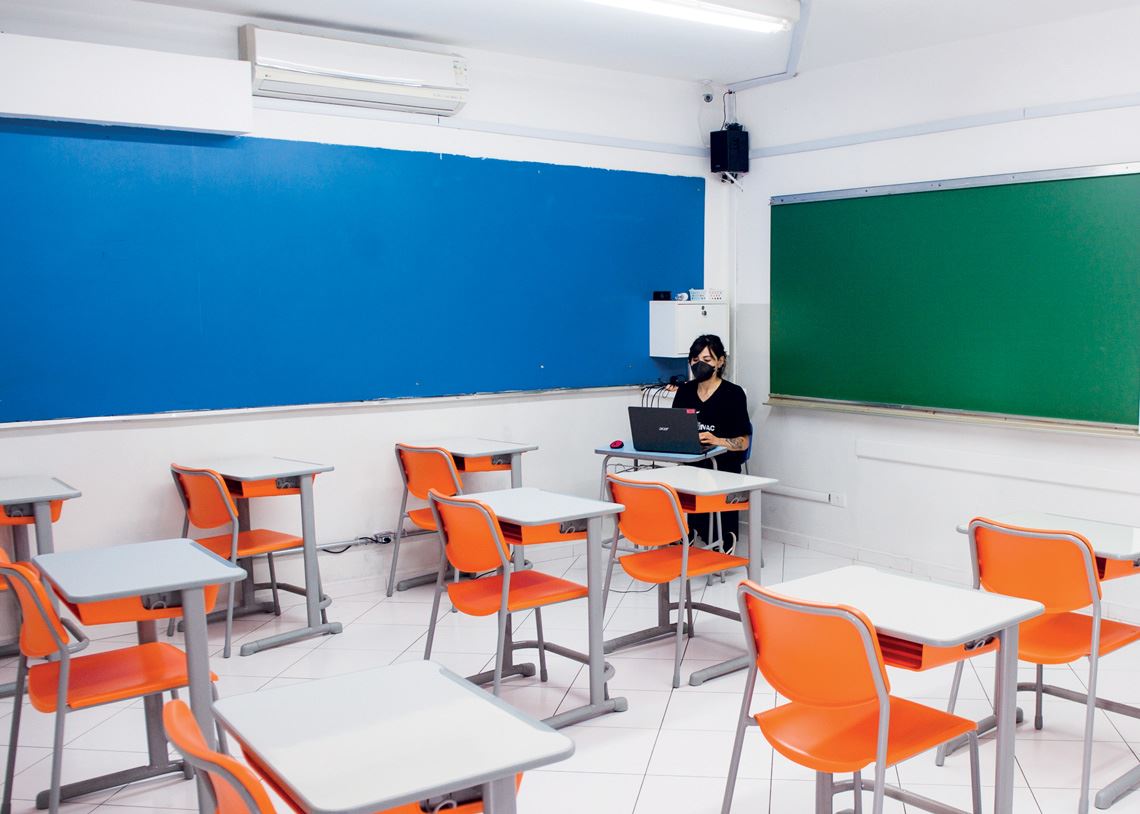
Léo Ramos Chaves
A teacher at a school participate in online classes in São PauloLéo Ramos ChavesUnlike the public schools, Ramos notes that private institutions were able to quickly adapt to remote schooling due to their superior financial circumstances and the socioeconomic level of their students. “On the other hand, these institutions have suffered budgetary impacts due to the high costs of offering these new methodologies and distance learning technologies, in addition to losing students,” he comments. Private schools account for 20% of enrollments in Brazil, with public schools responsible for the remaining 80%.
Even though the Ministry of Education has announced its intention to cancel the 2021 SAEB survey, researchers argue that one of the first steps necessary to develop strategies for alleviating learning deficits would be to carry out exactly such a large-scale, nationwide assessment. “The SAEB results could act as a basis for pedagogical coordinators to organize the academic recovery process,” Portela observes. José Francisco Soares, a professor emeritus at the Federal University of Minas Gerais (UFMG), argues that the SAEB should include items that would allow researchers to track how students and schools have functioned during the pandemic. “The SAEB survey must bring something to the educational institutions, not just record and collect data,” says Soares, who was president of INEP from 2014 to 2016. Offering a similar proposition, sociologist Maria Teresa Gonzaga Alves, from UFMG, defends the creation of analysis methodologies that would allow for more accurate diagnoses of education levels in times of pandemic. “The SAEB includes multiple choice exams. Under the current circumstances it would be more appropriate to develop tests for measuring writing ability using writing samples, so that it would be possible to identify how students are organizing their thoughts, something that multiple-choice tests don’t capture,” Alves suggests.
Scientific article
AMORIM, V. et al. The Effect of the H1N1 Pandemic on Learning: What to Expect with Covid-19. Open Knowledge Repository – World Bank Group. June 2020.
Reports
Acting Now to Protect the Human Capital of Our Children: The Costs of and Response to COVID-19 Pandemic’s Impact on the Education Sector in Latin America and the Caribbean. World Bank. March 2021.
Enfrentamento da cultura do fracasso escolar – Reprovação, abandono, e distorção idade-série. United Nations Children’s Emergency Fund (UNICEF). January 2021.
PORTELA, A. Síntese de evidências. O que sabemos sobre os efeitos da interrupção das aulas sobre os resultados educacionais? Centro de Aprendizagem em Avaliação e Resultados para o Brasil e a África Lusófona. São Paulo School of Economics at Fundação Getulio Vargas. In press.
SCHLEICHER, A. The impact of Covid-19 on education – Insights from Education at a glance. Organization for Economic Cooperation and Development (OECD). Sept. 2020.